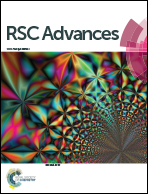Ecofriendly synthesis of a heterogeneous polyvinyl alcohol immobilized copper(ii) Schiff base complex as an efficient, reusable catalyst for the one-pot three-component green preparation of 5-substituted 1H-tetrazoles under mild conditions†
Abstract
A new heterogeneous and reusable polyvinyl alcohol immobilized copper(II) Schiff base complex (PVA@Cu(II) Schiff base complex) was synthesized in water, characterized and used for the highly efficient environmentally benign one-pot three-component preparation of 5-substituted 1H-tetrazole derivatives through the click reaction of aliphatic and aromatic aldehydes with hydroxylamine hydrochloride and azide salt as inexpensive and commercially available substrates in water with very short reaction times at room temperature.


 Please wait while we load your content...
Please wait while we load your content...